>>>>>>>>>
From First to Seventh Congress:
The Long March Continues
-- Arindam Sen
First Congress, May 1970
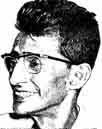 Two years after the formation of
the All India Coordination Committee of Communist Revolutionaries (AICCCR)
in May 1968 and a year after the foundation of Communist Party of India (Marxist-Leninist)
in April 1969, the first congress was held secretly on 15-16 May at Kolkata.
A 21-member central committee was elected, with Comrade Charu Mazumdar as
General Secretary. The congress adopted a General Programme and a Political
Organisational Report and called upon the Party ranks to intensify and expand
armed peasant struggle.
Two years after the formation of
the All India Coordination Committee of Communist Revolutionaries (AICCCR)
in May 1968 and a year after the foundation of Communist Party of India (Marxist-Leninist)
in April 1969, the first congress was held secretly on 15-16 May at Kolkata.
A 21-member central committee was elected, with Comrade Charu Mazumdar as
General Secretary. The congress adopted a General Programme and a Political
Organisational Report and called upon the Party ranks to intensify and expand
armed peasant struggle.
Formation of new Central Committee: July 1974
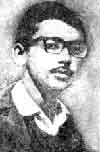
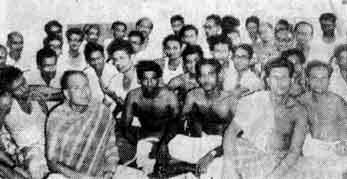 In
a situation of total ideological confusion following the setback and fragmentation
suffered by the Party in 1971-72, a new central committee was formed on 28
July 1974, the second anniversary of Comrade Charu Mazumdar’s martyrdom.
It consisted of comrades Jauhar (Subrata Dutta), secretary of the reorganised
Bihar State Committee, who was now elected General Secretary, Vinod Mishra,
secretary of the newly formed West Bengal State Leading Team; and Raghu (Swadesh
Bhattacharya), a close associate of Jauhar. The Central Committee vowed to
unite all communist revolutionaries of India on the basis of the revolutionary
essence of the political line formulated by Comrade Charu Mazumdar.
In
a situation of total ideological confusion following the setback and fragmentation
suffered by the Party in 1971-72, a new central committee was formed on 28
July 1974, the second anniversary of Comrade Charu Mazumdar’s martyrdom.
It consisted of comrades Jauhar (Subrata Dutta), secretary of the reorganised
Bihar State Committee, who was now elected General Secretary, Vinod Mishra,
secretary of the newly formed West Bengal State Leading Team; and Raghu (Swadesh
Bhattacharya), a close associate of Jauhar. The Central Committee vowed to
unite all communist revolutionaries of India on the basis of the revolutionary
essence of the political line formulated by Comrade Charu Mazumdar.
Second Congress: February 1976
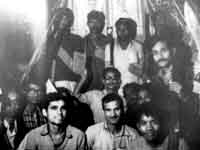 Comrade
Jauhar was martyred on 29 November 1975 and Comrade Vinod Mishra took over
as General Secretary. He took the initiative to hold a party congress as early
as possible, which took place on 26-27 February 1976 in Gaya district in Bihar.
It elected a 11-member central committee with Comrade VM as General Secretary
and maintained the stress on armed guerrilla struggle. It also introduced
the concept of an anti-Congress united front but did not elaborate on the
required political tactics.
Comrade
Jauhar was martyred on 29 November 1975 and Comrade Vinod Mishra took over
as General Secretary. He took the initiative to hold a party congress as early
as possible, which took place on 26-27 February 1976 in Gaya district in Bihar.
It elected a 11-member central committee with Comrade VM as General Secretary
and maintained the stress on armed guerrilla struggle. It also introduced
the concept of an anti-Congress united front but did not elaborate on the
required political tactics.
Special All India Conference : 1979
In January 1978 a rectification movement was launched with a view to overcoming
the militarist viewpoint and style of work and reemphasising mass peasant
movement. Soon, however, it began to transform our entire thought-process
and political line. The rectification movement was consummated in the form
of a special All India Conference held from 26 April to 2 May, 1979 in Bhojpur,
Bihar. As decided in the conference, trade unions, students’ organisations
and other mass organisations began to be formed while keeping the party strictly
underground, and vigorous bilateral as well as multi-lateral initiatives were
taken to unite the communist revolutionaries of India. The various class and
sectional organisations were later brought together under the umbrella of
the Indian People’s Front (IPF) launced in April 1982. As a mass political
organisation, IPF enabled the underground Party to take wide-ranging political
initiatives and to interact with numerous social and political forces throughout
the country.
Third Congress: December 1982

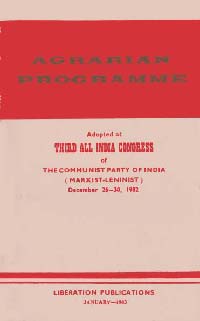 Held
in Giridih district of Bihar (now Jharkhand) from 26 to 30 December, the third
congress made a self-critical assessment of the Party’s formative years
while firmly upholding the fine revolutionary traditions. It adopted, for
the first time in CPI(ML) history, a separate Agrarian Programme in addition
to the General Programme, Constitution and Political Organisational Report,
and decided upon participation in elections under IPF banner on condition
that parliamentary struggle must be subordinated to extra-parliamentary movement
with peasants’ resistance struggle as the key link. Understandably,
this decision was taken only after an intense debate at all levels of the
Party prior to and at the congress itself. A central committee comprising
17 full and 8 alternative members was elected.
Held
in Giridih district of Bihar (now Jharkhand) from 26 to 30 December, the third
congress made a self-critical assessment of the Party’s formative years
while firmly upholding the fine revolutionary traditions. It adopted, for
the first time in CPI(ML) history, a separate Agrarian Programme in addition
to the General Programme, Constitution and Political Organisational Report,
and decided upon participation in elections under IPF banner on condition
that parliamentary struggle must be subordinated to extra-parliamentary movement
with peasants’ resistance struggle as the key link. Understandably,
this decision was taken only after an intense debate at all levels of the
Party prior to and at the congress itself. A central committee comprising
17 full and 8 alternative members was elected.
Fourth Congress: January 1988
 The fourth
congress held in Hazaribagh district of Bihar (now Jharkhand) from January
1 to 5, 1988 elected a 21-member central committee and a 3-member central
control commission. In this congress we abandoned certain wrong concepts like
viewing the Soviet Union as social-imperialism while condemning Gorbachev’s
theory of peaceful imperialism, and gave out the solgan of Left and Democratic
Confederation. The way for our interaction with the mainstream of the left
movement was thus paved. Also the congress decided to initiate the process
of opening up a section of Party which was implemented in the form of appointing
spokespersons at central and lower levels. Soon after the congress, the Party
had to launch a vigorous ideological campaign against a trend of liquidationist
renegacy which sought to obliterate our fundamental differences with the opportunist
Left. The whole Party rallied unitedly in this struggle to defend Marxism
and to reiterate three cardinal principles: primacy of revolutionary peasant
struggle in our multifarious activities; relentless fight against parliamentary
opportunism and social-democracy; absolute political independence and leading
role of the communist party in the democratic revolution. With higher ideological-political
and organisational consolidation, the Party achieved new breakthrough on the
peasant front and was able to send its representatives to the Lok Sabha (from
Arrah, Bihar) and to the Bihar Legislative Assembly in 1989-90.
The fourth
congress held in Hazaribagh district of Bihar (now Jharkhand) from January
1 to 5, 1988 elected a 21-member central committee and a 3-member central
control commission. In this congress we abandoned certain wrong concepts like
viewing the Soviet Union as social-imperialism while condemning Gorbachev’s
theory of peaceful imperialism, and gave out the solgan of Left and Democratic
Confederation. The way for our interaction with the mainstream of the left
movement was thus paved. Also the congress decided to initiate the process
of opening up a section of Party which was implemented in the form of appointing
spokespersons at central and lower levels. Soon after the congress, the Party
had to launch a vigorous ideological campaign against a trend of liquidationist
renegacy which sought to obliterate our fundamental differences with the opportunist
Left. The whole Party rallied unitedly in this struggle to defend Marxism
and to reiterate three cardinal principles: primacy of revolutionary peasant
struggle in our multifarious activities; relentless fight against parliamentary
opportunism and social-democracy; absolute political independence and leading
role of the communist party in the democratic revolution. With higher ideological-political
and organisational consolidation, the Party achieved new breakthrough on the
peasant front and was able to send its representatives to the Lok Sabha (from
Arrah, Bihar) and to the Bihar Legislative Assembly in 1989-90.
Special All India Conference: July 1990
This was our first conference organised under semi-secret conditions in
a big city (Delhi, 22-24 July). It took further steps in the process of opening
up, which had become necessary for boldly coming out in defence of Marxism
in a situation of crisis of socialism and for the Party’s direct intervention
in national politics. As decided in the conference, the Party began to be
opened up in graduated manner – with open party organs, seminars, participation
in rallies with Party banners (for instance, in the 8 October ’90 IPF
rally on Boat Club, Delhi) etc. to begin with – while keeping intact
the underground Party nucleus.
Fifth Congress: December 1992
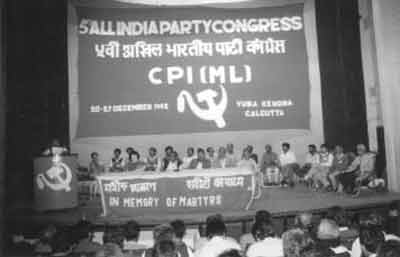
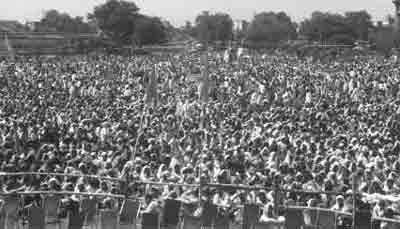 The
next major step in this direction of opening up and restructuring was the
holding of the next party congress openly in Kolkata on 20-26 December, followed
by a massive Party rally on the Brigade Parade Ground on 28 December, where
Comrade Vinod Mishra made his first public appearance after more than two
decades of underground operation. The congress called for militant mass resistance
to communal fascism under united Left leadership, reiterated the slogan of
Left Confederation and boldly put forward the perspective of uniting all Indian
communists in a single Party. A 17-member central committee (after a few months
8 more members were coopted) and a 3-member central control commission were
elected.
The
next major step in this direction of opening up and restructuring was the
holding of the next party congress openly in Kolkata on 20-26 December, followed
by a massive Party rally on the Brigade Parade Ground on 28 December, where
Comrade Vinod Mishra made his first public appearance after more than two
decades of underground operation. The congress called for militant mass resistance
to communal fascism under united Left leadership, reiterated the slogan of
Left Confederation and boldly put forward the perspective of uniting all Indian
communists in a single Party. A 17-member central committee (after a few months
8 more members were coopted) and a 3-member central control commission were
elected.
All India Organisational Plenum: July 1995
 To further streamline
and systematise the Party’s structure and functioning, a special organisational
conference – the first of its kind in our history – was organised
in Diphu, Karbi Anglong (Assam) on 28 and 29 July, 1995. It discussed, and
adopted specific decisions on a wide range of matters like raising the membership
strength and overcoming imbalances like low proportion of women in the membership
and in Party committees, strengthening party propaganda and education, freshly
developing a small underground structure in the midst of open party functioning
and so on. According to a decision adopted at the plenum, the Indian Institute
of Marxist Studies (IIMS) was founded to propagate Marxism and to facilitate
organised interaction with Marxist and progressive intellectuals.
To further streamline
and systematise the Party’s structure and functioning, a special organisational
conference – the first of its kind in our history – was organised
in Diphu, Karbi Anglong (Assam) on 28 and 29 July, 1995. It discussed, and
adopted specific decisions on a wide range of matters like raising the membership
strength and overcoming imbalances like low proportion of women in the membership
and in Party committees, strengthening party propaganda and education, freshly
developing a small underground structure in the midst of open party functioning
and so on. According to a decision adopted at the plenum, the Indian Institute
of Marxist Studies (IIMS) was founded to propagate Marxism and to facilitate
organised interaction with Marxist and progressive intellectuals.
Sixth Congress: October 1997
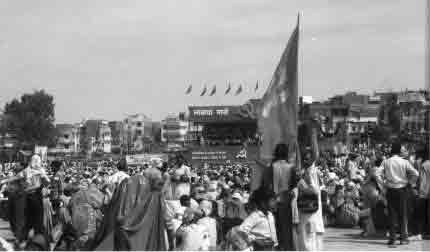
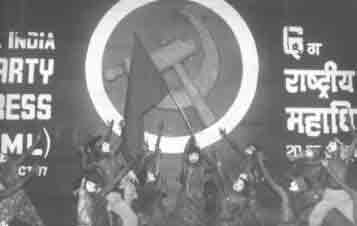 Held
in Varanasi – one of the main bastions of communal fascism – from
20 to 25 October 1997, the sixth congress made an observation that was soon
to prove prophetic: “the Indian ruling establishment is all set to welcome
a BJP takeover by the next elections, if not earlier.” The congress
therefore gave out the clarion call of resolute resistance to the saffron
menace. A 39-member central committee and a 5-member central control commission
were elected. As in all the previous congresses since the second (1976), Comrade
Vinod Mishra was reelected General Secretary.
Held
in Varanasi – one of the main bastions of communal fascism – from
20 to 25 October 1997, the sixth congress made an observation that was soon
to prove prophetic: “the Indian ruling establishment is all set to welcome
a BJP takeover by the next elections, if not earlier.” The congress
therefore gave out the clarion call of resolute resistance to the saffron
menace. A 39-member central committee and a 5-member central control commission
were elected. As in all the previous congresses since the second (1976), Comrade
Vinod Mishra was reelected General Secretary.
Towards Seventh Congress: November 2002
The year 1998 was one of major losses: we lost Central Committee member
Anil Kunmar Baruah in February, Polit Bureau member Nagbhushan Patnaik in
October and General Secretary Vinod Mishra in December. Comrade Dipankar Bhattacharya
was unanimously elected General Secretary, and the Party continued to march
forward. At the end of five eventful years, the stage is now set for the seventh
congress (Patna, 25-30 November) with more than 700 delegates, around 20 foreign
guests representing fraternal parties and organisations, and a distinguished
panel of observers including eminent literary and cultural personalities,
social activists, civil libertarians, intellectuals and mediapersons are expected
to participate.
(For more on Party history, see ‘CPI(ML) -- The Firm
Defender of the Revolutionary Legacy of Indian Revolution’ and ‘How
did our Party evolve?’, both included in the Selected Works of Vinod Mishra).
>>>>>>>>>
 Two years after the formation of
the All India Coordination Committee of Communist Revolutionaries (AICCCR)
in May 1968 and a year after the foundation of Communist Party of India (Marxist-Leninist)
in April 1969, the first congress was held secretly on 15-16 May at Kolkata.
A 21-member central committee was elected, with Comrade Charu Mazumdar as
General Secretary. The congress adopted a General Programme and a Political
Organisational Report and called upon the Party ranks to intensify and expand
armed peasant struggle.
Two years after the formation of
the All India Coordination Committee of Communist Revolutionaries (AICCCR)
in May 1968 and a year after the foundation of Communist Party of India (Marxist-Leninist)
in April 1969, the first congress was held secretly on 15-16 May at Kolkata.
A 21-member central committee was elected, with Comrade Charu Mazumdar as
General Secretary. The congress adopted a General Programme and a Political
Organisational Report and called upon the Party ranks to intensify and expand
armed peasant struggle.
 In
a situation of total ideological confusion following the setback and fragmentation
suffered by the Party in 1971-72, a new central committee was formed on 28
July 1974, the second anniversary of Comrade Charu Mazumdar’s martyrdom.
It consisted of comrades Jauhar (Subrata Dutta), secretary of the reorganised
Bihar State Committee, who was now elected General Secretary, Vinod Mishra,
secretary of the newly formed West Bengal State Leading Team; and Raghu (Swadesh
Bhattacharya), a close associate of Jauhar. The Central Committee vowed to
unite all communist revolutionaries of India on the basis of the revolutionary
essence of the political line formulated by Comrade Charu Mazumdar.
In
a situation of total ideological confusion following the setback and fragmentation
suffered by the Party in 1971-72, a new central committee was formed on 28
July 1974, the second anniversary of Comrade Charu Mazumdar’s martyrdom.
It consisted of comrades Jauhar (Subrata Dutta), secretary of the reorganised
Bihar State Committee, who was now elected General Secretary, Vinod Mishra,
secretary of the newly formed West Bengal State Leading Team; and Raghu (Swadesh
Bhattacharya), a close associate of Jauhar. The Central Committee vowed to
unite all communist revolutionaries of India on the basis of the revolutionary
essence of the political line formulated by Comrade Charu Mazumdar. Comrade
Jauhar was martyred on 29 November 1975 and Comrade Vinod Mishra took over
as General Secretary. He took the initiative to hold a party congress as early
as possible, which took place on 26-27 February 1976 in Gaya district in Bihar.
It elected a 11-member central committee with Comrade VM as General Secretary
and maintained the stress on armed guerrilla struggle. It also introduced
the concept of an anti-Congress united front but did not elaborate on the
required political tactics.
Comrade
Jauhar was martyred on 29 November 1975 and Comrade Vinod Mishra took over
as General Secretary. He took the initiative to hold a party congress as early
as possible, which took place on 26-27 February 1976 in Gaya district in Bihar.
It elected a 11-member central committee with Comrade VM as General Secretary
and maintained the stress on armed guerrilla struggle. It also introduced
the concept of an anti-Congress united front but did not elaborate on the
required political tactics.
 Held
in Giridih district of Bihar (now Jharkhand) from 26 to 30 December, the third
congress made a self-critical assessment of the Party’s formative years
while firmly upholding the fine revolutionary traditions. It adopted, for
the first time in CPI(ML) history, a separate Agrarian Programme in addition
to the General Programme, Constitution and Political Organisational Report,
and decided upon participation in elections under IPF banner on condition
that parliamentary struggle must be subordinated to extra-parliamentary movement
with peasants’ resistance struggle as the key link. Understandably,
this decision was taken only after an intense debate at all levels of the
Party prior to and at the congress itself. A central committee comprising
17 full and 8 alternative members was elected.
Held
in Giridih district of Bihar (now Jharkhand) from 26 to 30 December, the third
congress made a self-critical assessment of the Party’s formative years
while firmly upholding the fine revolutionary traditions. It adopted, for
the first time in CPI(ML) history, a separate Agrarian Programme in addition
to the General Programme, Constitution and Political Organisational Report,
and decided upon participation in elections under IPF banner on condition
that parliamentary struggle must be subordinated to extra-parliamentary movement
with peasants’ resistance struggle as the key link. Understandably,
this decision was taken only after an intense debate at all levels of the
Party prior to and at the congress itself. A central committee comprising
17 full and 8 alternative members was elected. The fourth
congress held in Hazaribagh district of Bihar (now Jharkhand) from January
1 to 5, 1988 elected a 21-member central committee and a 3-member central
control commission. In this congress we abandoned certain wrong concepts like
viewing the Soviet Union as social-imperialism while condemning Gorbachev’s
theory of peaceful imperialism, and gave out the solgan of Left and Democratic
Confederation. The way for our interaction with the mainstream of the left
movement was thus paved. Also the congress decided to initiate the process
of opening up a section of Party which was implemented in the form of appointing
spokespersons at central and lower levels. Soon after the congress, the Party
had to launch a vigorous ideological campaign against a trend of liquidationist
renegacy which sought to obliterate our fundamental differences with the opportunist
Left. The whole Party rallied unitedly in this struggle to defend Marxism
and to reiterate three cardinal principles: primacy of revolutionary peasant
struggle in our multifarious activities; relentless fight against parliamentary
opportunism and social-democracy; absolute political independence and leading
role of the communist party in the democratic revolution. With higher ideological-political
and organisational consolidation, the Party achieved new breakthrough on the
peasant front and was able to send its representatives to the Lok Sabha (from
Arrah, Bihar) and to the Bihar Legislative Assembly in 1989-90.
The fourth
congress held in Hazaribagh district of Bihar (now Jharkhand) from January
1 to 5, 1988 elected a 21-member central committee and a 3-member central
control commission. In this congress we abandoned certain wrong concepts like
viewing the Soviet Union as social-imperialism while condemning Gorbachev’s
theory of peaceful imperialism, and gave out the solgan of Left and Democratic
Confederation. The way for our interaction with the mainstream of the left
movement was thus paved. Also the congress decided to initiate the process
of opening up a section of Party which was implemented in the form of appointing
spokespersons at central and lower levels. Soon after the congress, the Party
had to launch a vigorous ideological campaign against a trend of liquidationist
renegacy which sought to obliterate our fundamental differences with the opportunist
Left. The whole Party rallied unitedly in this struggle to defend Marxism
and to reiterate three cardinal principles: primacy of revolutionary peasant
struggle in our multifarious activities; relentless fight against parliamentary
opportunism and social-democracy; absolute political independence and leading
role of the communist party in the democratic revolution. With higher ideological-political
and organisational consolidation, the Party achieved new breakthrough on the
peasant front and was able to send its representatives to the Lok Sabha (from
Arrah, Bihar) and to the Bihar Legislative Assembly in 1989-90.
 The
next major step in this direction of opening up and restructuring was the
holding of the next party congress openly in Kolkata on 20-26 December, followed
by a massive Party rally on the Brigade Parade Ground on 28 December, where
Comrade Vinod Mishra made his first public appearance after more than two
decades of underground operation. The congress called for militant mass resistance
to communal fascism under united Left leadership, reiterated the slogan of
Left Confederation and boldly put forward the perspective of uniting all Indian
communists in a single Party. A 17-member central committee (after a few months
8 more members were coopted) and a 3-member central control commission were
elected.
The
next major step in this direction of opening up and restructuring was the
holding of the next party congress openly in Kolkata on 20-26 December, followed
by a massive Party rally on the Brigade Parade Ground on 28 December, where
Comrade Vinod Mishra made his first public appearance after more than two
decades of underground operation. The congress called for militant mass resistance
to communal fascism under united Left leadership, reiterated the slogan of
Left Confederation and boldly put forward the perspective of uniting all Indian
communists in a single Party. A 17-member central committee (after a few months
8 more members were coopted) and a 3-member central control commission were
elected. To further streamline
and systematise the Party’s structure and functioning, a special organisational
conference – the first of its kind in our history – was organised
in Diphu, Karbi Anglong (Assam) on 28 and 29 July, 1995. It discussed, and
adopted specific decisions on a wide range of matters like raising the membership
strength and overcoming imbalances like low proportion of women in the membership
and in Party committees, strengthening party propaganda and education, freshly
developing a small underground structure in the midst of open party functioning
and so on. According to a decision adopted at the plenum, the Indian Institute
of Marxist Studies (IIMS) was founded to propagate Marxism and to facilitate
organised interaction with Marxist and progressive intellectuals.
To further streamline
and systematise the Party’s structure and functioning, a special organisational
conference – the first of its kind in our history – was organised
in Diphu, Karbi Anglong (Assam) on 28 and 29 July, 1995. It discussed, and
adopted specific decisions on a wide range of matters like raising the membership
strength and overcoming imbalances like low proportion of women in the membership
and in Party committees, strengthening party propaganda and education, freshly
developing a small underground structure in the midst of open party functioning
and so on. According to a decision adopted at the plenum, the Indian Institute
of Marxist Studies (IIMS) was founded to propagate Marxism and to facilitate
organised interaction with Marxist and progressive intellectuals.
 Held
in Varanasi – one of the main bastions of communal fascism – from
20 to 25 October 1997, the sixth congress made an observation that was soon
to prove prophetic: “the Indian ruling establishment is all set to welcome
a BJP takeover by the next elections, if not earlier.” The congress
therefore gave out the clarion call of resolute resistance to the saffron
menace. A 39-member central committee and a 5-member central control commission
were elected. As in all the previous congresses since the second (1976), Comrade
Vinod Mishra was reelected General Secretary.
Held
in Varanasi – one of the main bastions of communal fascism – from
20 to 25 October 1997, the sixth congress made an observation that was soon
to prove prophetic: “the Indian ruling establishment is all set to welcome
a BJP takeover by the next elections, if not earlier.” The congress
therefore gave out the clarion call of resolute resistance to the saffron
menace. A 39-member central committee and a 5-member central control commission
were elected. As in all the previous congresses since the second (1976), Comrade
Vinod Mishra was reelected General Secretary.